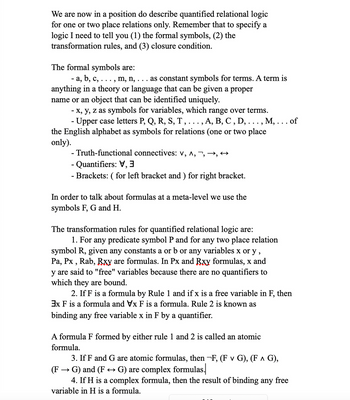4b. In the following exercises I give you the symbols that you will use for predicates or relations. Your task is to paraphrase the English sentences in quantified relational logic. For example, suppose you have the English sentence “Something is missing” (M, missing), then the paraphrase is ∃xMx. (i) All swans are white. (S, swan; W, white) (ii) Every swan is white. (S, swan; W,
4b. In the following exercises I give you the symbols that you will use for predicates or relations. Your task is to paraphrase the English sentences in quantified relational logic. For example, suppose you have the English sentence “Something is missing” (M, missing), then the paraphrase is ∃xMx.
(i) All swans are white. (S, swan; W, white)
(ii) Every swan is white. (S, swan; W, white)
(iii) Each swan is white. (S, swan; W, white)
(iv) Only white swans exist. (S, swan; W, white)
(v) A swan is white. (S, swan; W, white)
(The image is just formuals if your not familiar with this)

Step by step
Solved in 3 steps

4d. In the following exercises I give you the symbols that you will use for predicates or relations. Your task is to paraphrase the English sentences in quantified relational logic. For example, suppose you have the English sentence “Something is missing” (M, missing), then the paraphrase is ∃xMx.
(iv) Only white swans exist. (S, swan; W, white)
(v) A swan is white. (S, swan; W, white)
(The image is just formuals if your not familiar with this)









